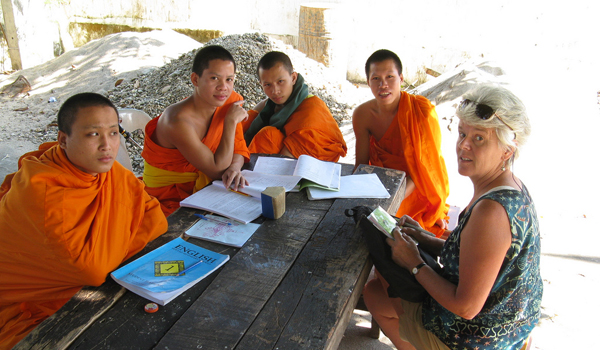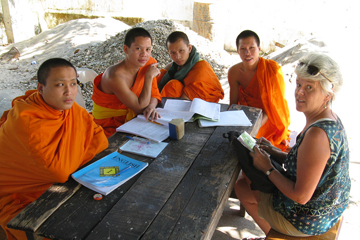
Imagine children learning to ‘read’ by looking at letters and words written on a chalkboard – if they have the luxury of attending school at all.



Imagine children learning to ‘read’ by looking at letters and words written on a chalkboard – if they have the luxury of attending school at all.
Imagine having to teach a child how to ‘work’ a book – how to turn the pages, one by one, to reveal the rest of the story, the next picture.

The place is rural Laos, where most of the seven million Laotians live. Villages are often remote, accessible by long and grueling bus-rides over rough dirt tracks, and then only during the dry season. Some are accessible only by slow river-boat, loaded to the gunwales with people and cargo. Many are accessible only on foot.
Life in these villages is virtually unchanged from what it was 50 or even 100 years ago. And it is a life without books.
Now imagine an organization dedicated to bringing books to the people of Laos, and in particular to the children in these small, remote villages. An organization that employs enthusiastic young Laotians as writers and artists, and publishes colourful books that make it fun and easy for Lao people to learn to read.
The organization is Big Brother Mouse. It was founded by Sasha Alyson – an American originally from Boston — and it is now owned by Khamla Panyasouk, a Laotian who works with Sasha to keep the presses running.
Big Brother Mouse started in March 2006 with the publication of five books. By the time we visited their outlets in Vientienne and Luang Prabang in November 2008, Big Brother Mouse had published almost 60 books.
The books are mostly in Lao, although some are in Lao and Hmong, and some are in Lao and English. Some are translations of old favourites like Aesop’s Fables, Dr. Dolittle, and The Wizard of Oz.
Big Brother Mouse has also published books on the kinds of subjects children love – dinosaurs, animals of Laos, Africa and Australia, and the wonders of the world. But most of the books are distinctly Lao: The Proverbs of Laos, New Improved Buffalo!, The Monk and the Trees, and A Very Good Day.
Big Brother Mouse has also started to publish some pocket-sized books that it hopes will be cheap enough, at around 50 cents each, that villagers will be able to buy them.

In addition to books for kids, Big Brother Mouse has published books in Lao for more experienced readers, such as Sherlock Holmes and The Diary of Anne Frank. And it has published some books on important subjects such as tooth decay, and how to look after a baby. It is currently working on a book about women’s health, including health in pregnancy.
The primary objective of Big Brother Mouse is to publish books. But its secondary objective is just as important: to experiment with different ideas for getting books out to rural and remote communities.
They have had considerable success with book parties. These are usually held in local schools. Big Brother Mouse staffers take enough books to the village to ensure that every child will be able to leave with a book of his or her choice.
The teacher is given a ‘swap box’ so that the kids can trade books with one another, giving them all a chance to read more. When Big Brother Mouse staffers have gone back to these schools they have found that the boxes, and the books, are still in use.
Another method Big Brother Mouse uses to distribute books is a system of junior librarians. Junior librarians may be young or old – what matters is that they love books and are willing to take responsibility for them. Their house becomes a library, where community members can go to borrow a book. The junior librarians are given 20 to 30 books to start.

From time to time Big Brother Mouse sponsors get-togethers for the junior librarians so they can talk about how they are doing and discuss any problems. For many, attending these get-togethers may be the first time they have been out of their communities. It represents both a way of rewarding and encouraging their participation in the project, and a tremendous opportunity for learning and community development.
When we visited Big Brother Mouse we met Siphone, a young writer. He remembers when he saw his first book, as a child in his village, and the impact that it had on him. He knows, first-hand, how a book can change a child’s life. He refers to Sasha and Khamla as his ‘big brothers’ – men who have helped him along his path – and his love for and admiration of them is clearly evident.
Big Brother Mouse is funded almost entirely by donations. It receives no money from the Laotian government. It does sell a few books to Laotians, and some tourists buy books to give to schools or to children they meet on their travels.
If you would like to find out more about Big Brother Mouse or make a donation, visit BigBrotherMouse.com
Better yet, make your next trip a trip to Laos, and visit Big Brother Mouse in Vientienne and Luang Prabang. Laos is a wonderful country to visit: an interesting culture, historic cities, unspoiled natural landscapes, friendly people and fabulous food. Buy some books and take them to a village, give them to children you meet.
Whether you go to Laos in person, or just visit the Big Brother Mouse website, you can give Laotian children the chance of a better future; you can give them books.
Headed to Laos? Matador Trips has several guides to the country’s hidden gems, including this article: A Unique Journey into the Heart of Northern Laos.